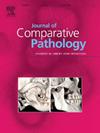Small canine mammary tumours have different prognostic factors: A study of 3,470 tumours
IF 0.8
4区 农林科学
Q4 PATHOLOGY
引用次数: 0
Abstract
Mammary gland neoplasms are the most frequent tumour in female dogs and most are malignant. Pet longevity and improvement in healthcare with early diagnosis increases the prevalence of cancer in animals. Tumour size is used as a prognostic factor to determine TNM (Tumour, Node, Metastasis) staging and considers tumours <3 cm, 3–5 cm and >5 cm. Due to the high rate of malignancy of mammary gland neoplasms, this study aimed to evaluate canine mammary tumours <3 cm and correlate the findings with clinicopathological parameters. A total of 3,470 mammary tumours were included and were classified as group 1 (G1, <1.5 cm) or group 2 (G2, 1.5–3 cm) as well as by prognosis – good, intermediate, poor or indeterminate. Clinicopathological parameters such as age, histological type, grade and lymph node status were analysed. The results revealed a significantly higher association of G1 tumours with non-neoplastic or benign diagnoses (P <0.001), a higher prevalence of histological grade I (P <0.001) and more frequent involvement of M2, M3 and M4 mammary glands (P <0.001). G2 tumours were significantly associated with a malignant diagnosis (P <0.001), higher prevalence of grades II and III (P <0.001), presence of lymph node metastasis (P <0.001) and involvement of the M5 mammary gland (P <0.001). Tumours with a good prognosis were most prevalent in dogs under 6 years old (mean 10 ± 2.8; P <0.0001) while a poor prognosis was significantly higher in dogs over 14 years old (mean 11.5 ± 2.8; P <0.0001). Tumours with an average size of 1.1 ± 0.7 cm had a significantly better prognosis (P <0.0001) and those with an average size of 1.6 ± 0.8 cm had a worse prognosis (P <0.0001). Histological type had an important role even in small tumours. Canine mammary tumours <1.5 cm and >1.5 cm had important differences in prognosis and highlight the need for a review of the minimal tumour size established in TNM staging for canine mammary gland tumours.
犬乳腺小肿瘤具有不同的预后因素:一项对3,470个肿瘤的研究
乳腺肿瘤是雌性犬中最常见的肿瘤,并且大多数是恶性的。宠物寿命的延长和医疗保健的改善以及早期诊断增加了动物癌症的患病率。肿瘤大小被用作确定TNM(肿瘤、淋巴结、转移)分期的预后因素,并考虑肿瘤大小为3厘米、3 - 5厘米和5厘米。由于乳腺肿瘤的高恶性率,本研究旨在评估犬乳腺肿瘤<; 3cm,并将其与临床病理参数相关联。共纳入3470例乳腺肿瘤,分为1组(G1, 1.5 cm)或2组(G2, 1.5 - 3 cm),并根据预后-好、中、差或不确定进行分类。分析年龄、组织学类型、分级、淋巴结状况等临床病理参数。结果显示G1肿瘤与非肿瘤性或良性诊断的相关性显著提高(P <0.001),组织学分级I的患病率更高(P <0.001), M2、M3和M4乳腺的受累率更高(P <0.001)。G2肿瘤与恶性诊断(P <0.001)、II级和III级较高的患病率(P <0.001)、淋巴结转移的存在(P <0.001)和M5乳腺的累及(P <0.001)显著相关。预后良好的肿瘤在6岁以下的狗中最常见(平均10±2.8;P <0.0001),而14岁以上犬的不良预后显著增加(平均11.5±2.8;P & lt; 0.0001)。平均大小为1.1±0.7 cm的肿瘤预后较好(P <0.0001),平均大小为1.6±0.8 cm的肿瘤预后较差(P <0.0001)。即使在小肿瘤中,组织学类型也起着重要作用。犬乳腺肿瘤& 1.5 cm和>;1.5 cm在预后方面有重要差异,并强调需要对犬乳腺肿瘤TNM分期中建立的最小肿瘤大小进行审查。
本文章由计算机程序翻译,如有差异,请以英文原文为准。
求助全文
约1分钟内获得全文
求助全文
来源期刊
CiteScore
1.60
自引率
0.00%
发文量
208
审稿时长
50 days
期刊介绍:
The Journal of Comparative Pathology is an International, English language, peer-reviewed journal which publishes full length articles, short papers and review articles of high scientific quality on all aspects of the pathology of the diseases of domesticated and other vertebrate animals.
Articles on human diseases are also included if they present features of special interest when viewed against the general background of vertebrate pathology.

 求助内容:
求助内容: 应助结果提醒方式:
应助结果提醒方式:


